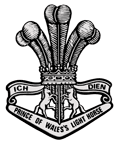 The 4th/19th Prince of Wales’s Light Horse has a long and proud history. As the name implies, the origin of the Regiment is in 3 separate organisations, the 17th Prince of Wales’s Light Horse, the 19th Yarrowee Light Horse and the 4th (Ex 20th) Corangamite Light Horse. The amalgamation which occurred on 1 April 1948 is a relatively recent change in the history of the three Regiments.
The 4th/19th Prince of Wales’s Light Horse has a long and proud history. As the name implies, the origin of the Regiment is in 3 separate organisations, the 17th Prince of Wales’s Light Horse, the 19th Yarrowee Light Horse and the 4th (Ex 20th) Corangamite Light Horse. The amalgamation which occurred on 1 April 1948 is a relatively recent change in the history of the three Regiments.
Like many of Australia’s proudest Regiments, the 17th Light Horse was raised as part of the volunteer movement which began during the Crimean War. On 1 October 1860 one of the first Victorian Mounted units was raised, the Kyneton District Mounted Rifle Corps, which was to form part of the Royal Volunteer Cavalry Regiment. This unit was granted the title Prince of Wales’s in 1862. The unit badge at this time was based on the Prince of Wales’s personal crest and together with the motto “Ich Dien” (I serve), the ostrich plumes have survived to be the basis of the Regiment’s badge today.
In common with the 17th Light Horse, the 19th Light Horse descends from the Royal Volunteer Cavalry Regiment and also has suffered many changes in name and in role. By 1885 the Victorian Mounted Rifles had been raised and members of this unit went to South Africa. There was no 17th or 19th Light Horse in the 1st AIF, however in recognition of the service of the men of these units in South Africa and the Great War; both have been granted battle honours for South Africa, Gallipoli, Egypt and Palestine.
The record of the 4th Light Horse in the 1914 -18 war is without equal in the AIF. It was the only Australian unit to see service on all three fronts, France, Gallipoli and Palestine and was granted a total of 24 Battle Honours of which only 10 can be carried on the Guidon. Probably the most notable action of the 4th Light Horse was the Charge at Beersheba on 31 October, 1917, an action which is commemorated each year by the serving soldiers of the Regiment. The Regiment has been granted 35 Battle Honours from all conflicts.
For most of the Second World War the three Regiments served in Australia under various other Regimental titles as home troops. Only the 2nd/4th Armoured Regiment, which is deemed to be the successor of the 4th Light Horse from the 1st AIF, saw active service late in the war in New Guinea and at Bougainville.
When the Citizens Military Forces were reformed in 1948 it was decided to perpetuate the traditions of the 4th Light Horse, the 17th Prince of Wales’s Light Horse and the 19th Light Horse. During the Vietnam conflict the first Australian Armoured Corps troops into action in 1965 were 1 APC Troop which was formed from A Squadron, 4th/19th Prince of Wales’s Light Horse for which it was awarded a United States Army Citation for its service. The tradition continues with members of A Squadron having served in East Timor and other members in the Solomons Islands. In December 1990 8/13 VMR was linked with the Regiment and now carries on the traditions and history of the 4th,8th,13th,17th,19th and 20th Regiments of Light Horse.
Today the Regiment is based in Melbourne and has two squadrons, A Squadron in country Victoria with depots at Sale, Bairnsdale, and Bandiana with Regimental Headquarters and B Squadron being located within Simpson Barracks at Watsonia. The Regiment is proud to have been granted the Freedom of Entry to seven cities they being Sale, Melbourne, Fitzroy, Kyneton, Traralgon, Bairnsdale and Beechworth.
